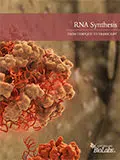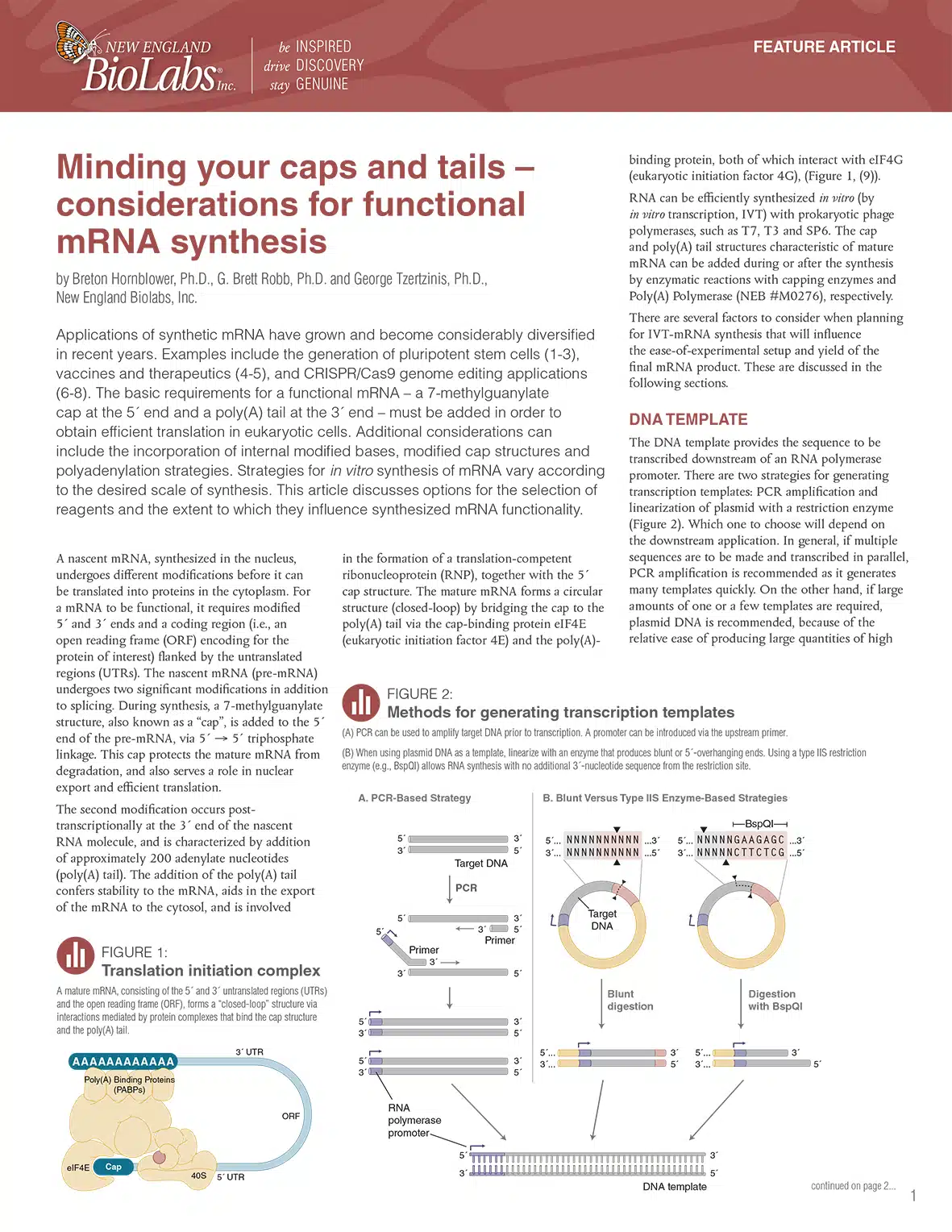Background
In vitro synthesis of single-stranded RNA molecules is a routine laboratory procedure that is essential to the rapidly developing field of RNA research. This technique is versatile in that it allows the researcher to tailor synthesis, and introduce modifications that produce a transcript that is optimal for use in downstream applications. Though the ways in which RNA can be produced are countless, the same basic procedure is followed in all synthesis protocols.
Our free brochure:
RNA Synthesis –
From Template to Transcript

Feature Article:
Minding your caps and tails – considerations for functional mRNA synthesis
Workflow Details
Template Generation
The first step in in vitro RNA synthesis is to prepare the DNA template corresponding to the sequence of interest. To allow run off transcription, plasmid DNA template is generally linearized with a restriction enzyme. In addition to plasmid DNA, PCR products and synthetic oligonucleotides can be used as templates for transcription reactions. We recommend Q5 High-Fidelity DNA Polymerase if you plan to use a PCR product as template.
In vitro Synthesis
The template DNA is transcribed by a T7, T3 or SP6 RNA phage polymerase in the presence of ribonucleoside triphosphates (rNTPs). The polymerase traverses the template strand and uses base pairing with the DNA to synthesize a complementary RNA strand (using uracil in the place of thymine). The RNA polymerase travels from the 3′ → 5′ end of the DNA template strand, to produce an RNA molecule in the 5′ → 3′ direction.
The HiScribe™ T7 Quick High Yield RNA Synthesis Kit is designed for quick set-up and production of large amounts of RNA in vitro. The reaction can be set up conveniently by combining the NTP buffer mix, T7 RNA Polymerase mix and a suitable DNA template. The kit also allows for capped RNA or dye-labeled RNA synthesis by incorporation of cap analog (ARCA) or dye-modified nucleotides. The HiScribe™ T7 High Yield RNA Synthesis Kit is an extremely flexible system for in vitro transcription of RNA using T7 RNA Polymerase. The kit allows for synthesis many kinds of RNA including internally labeled and co-transcriptionally capped
Combined RNA Synthesis and Modification
For combined RNA synthesis and modification NEB offers the HiScribe™ T7 ARCA mRNA Kit and the HiScribe™ T7 ARCA mRNA Kit (with tailing).
Both kits include reagents need for RNA synthesis, modification and clean-up.transcripts.
RNA Modification
mRNAs synthesized in vivo by eukaryotic organisms are co-transcriptionally modified by the addition of a a cap structure, which consists of a 5′ 7-methyl guanosine residue that protects the transcript from nuclease digestion and promotes translation. Additionally, eukaryotic mRNAs are 3’-polyadenylated by a template independent polymerase. The poly(A) tail also functions in mRNA stability and translational regulation.
For experiments where RNA will be introduced into cells by transfection or microinjection, in vitro transcripts can be modified to mimic mRNA by using the Faustovirus Capping Enyzme (FCE). Faustovirus Capping Enzyme (FCE) is a single-subunit enzyme that catalyzes the addition of N7-methylguanosine cap (m7G) to the 5′ end of triphosphorylated and diphosphorylated transcripts, producing Cap-0 RNA. FCE retains significant capping activity at low temperatures and tolerates reaction temperatures up to 55°C. FCE offers best value with improved capping efficiency, even on difficult substrates.
Moreover, we offer mRNA capping enzymes from vaccinia virus to add cap structures, and E. coli poly(A) polymerase to add poly(A) tails.
Alternatively, cap structure analogs, such as (m7G(5′)ppp(5′)G), may be used to co-transcriptionally cap RNA transcripts during synthesis.
Synthesized RNA can be used in a number of applications including RNA structure and function studies, ribozyme biochemistry, probes for RNase protection assays and hybridization based blots, anti-sense RNA and RNAi experiments, microarray analysis, microinjection, in vitro translation, and RNA vaccines.
Please use our RNA Cap Analog Selection Chart to find a suitable Cap Analog for your experiment.
RNA Clean-Up
After successful in vitro transcription the template is degraded either with DNaseI or DNaseI-XT (recommended), which is a superior DNaseI variant and active at higher salt concentrations typical for IVT reactions. mRNAs can be affinity purified with Oligo(dT)Beads.
mRNA synthesis workflow example & available NEB products
(Click on the respective box/product for more product information)
Further information can be found in our Technical Resources section or at neb.com. Information on trademarks can be found here.


